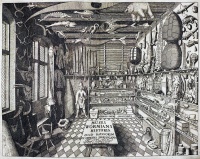Cataloging (library science)
From The Art and Popular Culture Encyclopedia
| Revision as of 19:08, 13 July 2008 Jahsonic (Talk | contribs) ← Previous diff |
Current revision Jahsonic (Talk | contribs) |
||
| Line 1: | Line 1: | ||
| + | [[Image:Musei Wormiani Historia.jpg|thumb|left|200px|The ''Museum Wormianum'' (1654), the [[cabinet of curiosities]] by [[Ole Worm]]]] | ||
| + | {| class="toccolours" style="float: left; margin-left: 1em; margin-right: 2em; font-size: 85%; background:#c6dbf7; color:black; width:30em; max-width: 40%;" cellspacing="5" | ||
| + | | style="text-align: left;" | | ||
| + | "I had beside me several of the [[Cataloging (library science) |catalogue]]s of the older [[cabinet of curiosities|collections]] [...]. I often consulted them and found both amusement and instruction in turning over their pages, and it seemed to me that from such sources one could learn something of the idea of what a [[museum]] ought to be, which the old collectors had, their [[Classification scheme (information science)|schemes of classification]] and the science on which these were based."--''[[Museums: Their History and Their Use with a Bibliography and List of Museums in the United Kingdom]]'' (1904) by David Murray | ||
| + | |} | ||
| + | |||
| {{Template}} | {{Template}} | ||
| - | A '''catalog''' or '''catalogue''' is an organized, detailed, descriptive list of items arranged systematically. It may also refer to a list of items enumerated with a specific [[numbering scheme]]. The word comes from the Hesiodic ''[[Catalogue of Women]]'' or ''Eoiae''. | + | |
| + | In [[library and information science]], '''cataloguing''' (UK) or '''cataloging''' (US) is the process of creating [[metadata]] representing information [[resource]]s, such as books, sound recordings, moving images, etc. Cataloging provides information such as creator names, titles, and subject terms that describe resources, typically through the creation of [[bibliographic record]]s. The records serve as surrogates for the stored information resources. Since the 1970s these metadata are in [[machine-readable form]] and are indexed by information retrieval tools, such as [[bibliographic database]]s or [[search engine]]s. While typically the cataloging process results in the production of [[library catalog]]s, it also produces other types of discovery tools for [[document]]s and collections. | ||
| + | |||
| + | The word comes from the Hesiodic ''[[Catalogue of Women]]'' or ''Eoiae''. | ||
| + | |||
| + | ==See also== | ||
| + | * [[Anglo-American Cataloguing Rules]] (AACR) | ||
| + | * [[Archival processing]] | ||
| + | * [[Authority control]] | ||
| + | * [[Bibliographer]] | ||
| + | * [[Bibliographic record]] | ||
| + | * [[Cataloging in Publication]] | ||
| + | * [[Collaborative Cataloging]] (shared cataloging) | ||
| + | * [[Findability]] | ||
| + | * [[Functional Requirements for Bibliographic Records]] (FRBR) | ||
| + | * [[Information architecture]] | ||
| + | * [[Information retrieval]] | ||
| + | * [[International Standard Bibliographic Description]] (ISBD) | ||
| + | * [[ISO 690]] | ||
| + | * [[Knowledge organization]] | ||
| + | * [[Library catalog]] | ||
| + | * [[Metadata]] | ||
| + | * [[Subject access point]] | ||
| + | |||
| + | {{GFDL}} | ||
| + | |||
| + | |||
| + | |||
| {{GFDL}} | {{GFDL}} | ||
Current revision
|
"I had beside me several of the catalogues of the older collections [...]. I often consulted them and found both amusement and instruction in turning over their pages, and it seemed to me that from such sources one could learn something of the idea of what a museum ought to be, which the old collectors had, their schemes of classification and the science on which these were based."--Museums: Their History and Their Use with a Bibliography and List of Museums in the United Kingdom (1904) by David Murray |
|
Related e |
|
Featured: |
In library and information science, cataloguing (UK) or cataloging (US) is the process of creating metadata representing information resources, such as books, sound recordings, moving images, etc. Cataloging provides information such as creator names, titles, and subject terms that describe resources, typically through the creation of bibliographic records. The records serve as surrogates for the stored information resources. Since the 1970s these metadata are in machine-readable form and are indexed by information retrieval tools, such as bibliographic databases or search engines. While typically the cataloging process results in the production of library catalogs, it also produces other types of discovery tools for documents and collections.
The word comes from the Hesiodic Catalogue of Women or Eoiae.
See also
- Anglo-American Cataloguing Rules (AACR)
- Archival processing
- Authority control
- Bibliographer
- Bibliographic record
- Cataloging in Publication
- Collaborative Cataloging (shared cataloging)
- Findability
- Functional Requirements for Bibliographic Records (FRBR)
- Information architecture
- Information retrieval
- International Standard Bibliographic Description (ISBD)
- ISO 690
- Knowledge organization
- Library catalog
- Metadata
- Subject access point


